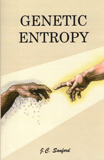
Semi-Homemade Life
Abstract
Synthetic biologists are convinced their methods will eventually allow them to create life from non-life, but Darwinian evolution cannot bridge the gap.
Keywords: synthetic life, artificial life, biology, genetics, intelligence, information, mutations, scientists, chance, time, natural laws, genome, Darwinian evolution
A recent flurry of articles about “synthetic” or “artificial” life, have dominated the media over the last several months.1 The field of synthetic biology is not a new one, but recent advances have made this a particularly “hot” topic. After reading the articles, I was very much reminded of a cooking show I sometimes watch which has the phrase “semi-homemade” in the title. The premise of the cooking show is to take ready-made products, such as a roasted chicken, from the grocery store and combine with a sauce made from scratch. The meal gives the impression that someone worked all day in the kitchen to prepare it, even though that is false. Similarly, scientists are taking designed parts (by God or themselves), assembling them, and claiming they are close to creating life. They also believe this will support the idea that chance, time, and natural laws can bring life from non-life. The impression is that it’s easy to create life from non-life, but again this is false.
What Is Synthetic Biology?
Synthetic biology covers several areas, two of which are relevant to the recent news reports. In the early ’80s synthetic biology was used to describe genetically altered bacteria.2 “These bacteria are living systems (therefore biological) that have been altered by human intervention (that is, synthetically).”2 Bacteria are altered for numerous reasons with both research and clinical applications. For example, a form of human insulin (known as Humulin N) is produced by the bacterium Escherichia coli, which no doubt has helped thousands of people with type 1 diabetes.3
Another definition of synthetic biology became prevalent in the early 2000s.
Synthetic biologists seek to assemble components that are not natural (therefore synthetic) to generate chemical systems that support Darwinian evolution (therefore biological). By carrying out the assembly in a synthetic way, these scientists hope to understand non-synthetic biology, that is, ‘natural’ biology.2
I would liken this to the difference between working out a math problem on paper to using a calculator in math class. The first method will help you understand the operations by which math functions much better than letting a calculator do the work for you. By trying to create life, scientists are learning more than they could by just observing life. For example, some scientists have attempted to create artificial genetic systems using nucleotides other than those found in DNA (represented by the letters A, T, C, and G).2 Although the premise may be faulty (trying to simulate evolution that has yet to be successful), the research has led to a greater understanding of how proteins interact with DNA, the importance of certain components of DNA structure, and so on.2
Synthetic Hype AboutSsynthetic Life
Recent work by Craig Venter (who played a major role in sequencing the human genome) falls under the first definition of synthetic biology. Venter took the genome of the bacterium Mycoplasma mycoides and transplanted it into the bacterium Mycoplasma capricolum.4 After multiple rounds of selection, the M. carpricolum lost its own genome and now contained only the genome of M. mycoides.4 Further testing confirmed that the M. carpricolum had become the donor strain of M. mycoides.4 This was heralded as the “creation of a synthetic lifeform” or “first new form of artificial life” giving the impression that Venter had created life in the lab.5 Venter corrects these sensationalistic headlines by stating that he was instead “modifying life to come up with new life forms”.6 His goal is to eventually replace a bacterial genome with a completely synthetic (man-made) genome that would allow the bacteria to digest toxic wastes or produce clean fuels.5
It is debatable as to whether this will be successful considering that the genome “swap” was between two very closely related bacteria, and Venter is considering introducing a completely foreign man-made chromosome into a bacterium. David DeWitt of Liberty University states:
I am impressed with the technology and the technique and that they got it to work. I am not as impressed with the implications. So you can swap a hard drive between 2 IBM laptops. Putting it in a Mac is something totally different.
If he does get it to work, Venter is masterfully re-engineering genetic material and bacteria that God created to be useful to mankind, which would fall under the dominion mandate given to man (Gen. 1:26).
An Associated Press release picked up by many news outlets claimed “artificial life likely in 3 to 10 years.”7 This artificial or synthetic life would fall under the second definition of synthetic biology given above—trying to create life from non-life. Mark Bedau of ProtoLife states, “This [creating synthetic life] will remove one of the few fundamental mysteries about creation in the universe and our role.”7 What intrigued me was the fact that the AP release was not based on any specific new advancement in synthetic biology as reported in a peer-reviewed scientific journal. It appears to be a compilation of quotes and ideas from synthetic biologists. Needless to say, I was disappointed in the lack of substance behind the media hype. Is it possible that all the recent media attention given to the Creation Museum has evolutionists worried? Or maybe it was a fundraising idea. George Church of Harvard Medical School states, “These things aren’t so much a question of timescales [building a synthetic cell] as the amount of money available.”8
What “hurdles” do these scientists face before they can create synthetic life? The AP article states three:7
- Creating a membrane that is selective about what goes in and out of the cell
- Creating a genetic system that allows the organism to reproduce and change according to its environment
- Creating metabolism so the cell can convert food into energy
Just How EasyWwould It Be?
According to Jack Szostak of Harvard Medical School, creating a cell membrane is likely to be achieved soon and is “not a big problem”.7 This statement is misleading considering the complexity of the cell membrane. Dr. Aw Swee-Eng, a biblical creationist and scientist, states, “People can spend their lifetime just studying the cell membrane; entire departments in universities study just the chemical ‘pumps’ that keep the integrity of the membrane.”9 Even if they do manage to “create” a cell membrane, it would not be from scratch. They are starting with fatty acids and proteins that they have designed. How can one use this to claim that intelligence was not needed, only chance, time, and natural laws for life to originate from non-life?
This reminds me of an imaginary dialog between a scientist and God. A scientist tells God that they no longer need Him because of all the things “science” can now do. God challenges him to a man-making contest, to which the scientist agrees. God says He wants the scientist to do just like He did when He created Adam starting with dirt. The scientist agrees and picks up some dirt, to which God replies, “No, no, no. You go get your own dirt!” To today’s scientists who think they are showing in the lab that life can come from non-life all I have to say is, “Get your own dirt!”
He is assuming that the gap between non-life and life has been filled—despite the lack of evidence.
To create the genetic system, Szostak indicated that if scientists can add nucleotides [again these nucleotides were designed by the scientists (artificial) or God (natural) so this is not an example of chance, time, and natural laws bringing life from non-life] in the right proportions inside the cell membrane then evolution will take over and a genetic system will be created.7 Szostak stated, “We aren’t smart enough to design things, we just let evolution do the hard work and then we figure out what happened.”7 In making this statement, he is assuming that the gap between non-life and life has been filled—despite the lack of evidence. Darwinian evolution can only work on information in a genetic system that already exists; it does not function to create a genetic system necessary for life to originate from non-life. Information requires an immaterial source (and in the case of DNA—an intelligent immaterial source!) but according to an atheistic evolutionary worldview, the immaterial is not allowable. Evolutionary belief must resort to just-so stories to fill in the gap.
In addition, it is assumed that once this genetic system is created in the cell, then mutations will allow the cell to adapt to its environment. Mutations do not add information. Even synthetic biologists are frank about what mutations can accomplish. Steven Benner and Michael Sismour of the University of Florida state,
Losing genetic information is much easier than obtaining new information. By contrast with the power of Darwinian processes implied by the Jurassic Park principle (‘life finds a way’), Darwinian processes are highly conservative when it comes to creating new functions. When tackling new problems, Darwinian systems take small steps from what they already have; they are not innovators on a large scale.2
They infer that mutations are usually harmful not helpful, but as always Darwinian evolution “finds a way” (since when are scientific principles based off sci-fi movies?).
Metabolism and the ability to convert food into energy are extremely complex processes whether discussing bacteria or man. Even if the proteins and other components (again they were designed by man or God, thus not supporting the idea that chance, time, and natural laws can bring life from non-life) necessary to do this were supplied to a synthetic cell, it would not pass this information to future generations of cells. The information would need to be coded in the genetic system for this to occur. According to an evolutionary worldview there is nothing immaterial, yet the information in the DNA requires an intelligent immaterial source.
For those of you worried that synthetic life might someday leave the lab and wreak havoc on our society, do not be concerned. Bedau states, “When these things [synthetic cells] are created, they’re going to be so weak, it’ll be a huge achievement if you can keep them alive for an hour in the lab.”7 Benner and Sismour agree:
The 30 years of experience with genetically altered organisms since Asilomar have indicated that virtually any human-engineered organism is less fit than its natural counterpart in a natural environment. If they survive at all in the environment, they do so either under the nurturing of an attentive human, or by ejecting their engineered features.2
Basically, mankind cannot come anywhere near creating something, even the “simplest” bacteria, as well as the Creator God.
Conclusion
Synthetic biologists are convinced their methods will eventually allow them to create life from non-life. Benner and Sismour state,
Because of the robustness of the interchangeable parts in the expanded genetic information systems [the artificial genetic systems the scientists designed], we suspect that an artificial chemical system that supports Darwinian evolution—the bridge between non-life and life—will first be obtained with these.2
Once again Darwinian evolution cannot bridge the gap. The gap is assumed to have been filled by some unknown mechanism that the scientists are sure exists and that they will one day discover.
There are two major problems that these scientists are facing in creating synthetic life and using it to support the idea that life can come from non-life through chance, time, and natural laws. First, information (such as that found in a genetic system) requires an intelligent, immaterial source. Where did the information come from? In their materialistic worldview, there is no source for the information. They must account for its existence within their worldview, which they cannot. Second, they are creating a synthetic cell using parts they designed, such as fatty acids, proteins, and nucleotides. By doing so, they have disregarded the idea that chance, time, and natural laws are sufficient to bring into existence the starting products for life.
No such problem exists for those using a biblical worldview. The information for life was supplied by the intelligent Creator God as part of His original creation on Days Three, Five, and Six. Plants, microbes, animals, and man were created fully formed not requiring chance, time, and natural laws (which would not work anyway) to bring them into existence.
Synthetic biology is an exciting field where much about God’s creation can be learned by using the “do-it-yourself” mentality towards creating life. We pray that these scientists will recognize that they will always be apprentices and never the Master of creating life.
Further Reading
- Get Answers: Origin of Life, Genetics, Science, Information Theory
Footnotes
- The term life used in this article refers to biological life, which is defined as “anything that contains genetic information, can reproduce offspring that resemble itself, grows and develops, controls cellular organization and conditions including metabolism and homeostasis, and responds to its environment” (Evolution Exposed, p. 235).
- Steven Benner and Michael Sismour, “Synthetic Biology,” Nature Reviews Genetics 6 (2005): 533–543, http://www.nature.com/nrg/journal/v6/n7/abs/nrg1637.html.
- “Humulin N,” RxList, http://www.rxlist.com/humulin-n-drug.htm.
- Carole Lartigue, et al, “Genome Transplantation in Bacteria: Changing One Species to Another,” Science 317 (2007): 632–638, doi:10.1126/science.1144622.
- Roger Highfield, “First Artificial Life ‘Within Months’,” The Telegraph, June 29, 2007, http://www.telegraph.co.uk/news/worldnews/1555890/First-artificial-life-within-months.html.
- Seth Borenstein, “What Exactly Is Life?,” NBC News, August 19, 2007, http://www.nbcnews.com/id/20249616/.
- Seth Borenstein, “Artificial Life LIkely in 3 to 10 Years,” The Washington Post, August 20, 2007, http://www.washingtonpost.com/wp-dyn/content/article/2007/08/19/AR2007081901408_pf.html.
- Peter Aldhous, “Countdown to a Synthetic Lifeform,” New Scientist, July 4, 2007, https://www.newscientist.com/article/mg19526114-000-countdown-to-a-synthetic-lifeform/.
- Carl Wieland, “Chemical soup is not your ancestor!,” Creation, 16:46–47.
Recommended Resources

Answers in Genesis is an apologetics ministry, dedicated to helping Christians defend their faith and proclaim the good news of Jesus Christ.
- Customer Service 800.778.3390
- © 2024 Answers in Genesis





